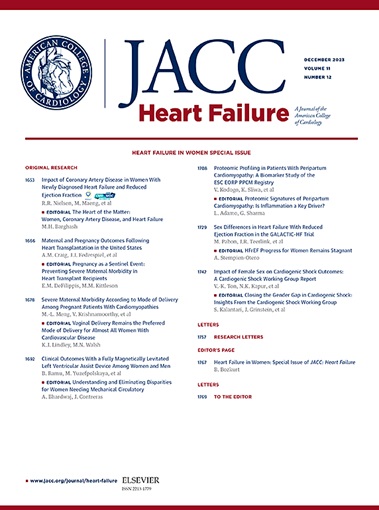应用可穿戴传感器和人工智能无创评估心力衰竭患者肺毛细血管楔压。
IF 10.3
1区 医学
Q1 CARDIAC & CARDIOVASCULAR SYSTEMS
引用次数: 0
摘要
背景:采用植入式肺动脉压力传感器的远程血流动力学指导心力衰竭(HF)治疗已被证明可以减少HF住院率。该手术的广泛临床应用受到其侵入性和高成本的限制。我们提出了一种基于可穿戴传感器(CardioTag;心力衰竭伴射血分数降低(HFrEF)患者肺动脉毛细血管楔压(PCWP)的评估。目的:作者开发并评估了(针对右心导管[RHC])一个ML模型,利用CardioTag的心电图、地震心动图和光容积脉搏波信号来估计PCWP。方法进行一项多中心前瞻性研究,在住院和门诊招募310例HFrEF (EF≤40%)患者。盲法核心实验室判定RHC PCWP示踪产生标准PCWP标签,模型据此进行训练和测试。数据被分成2组:用于模型训练和微调的训练集,以及在最终评估之前不公开的测试集。结果患者年龄为61±13岁,女性占38%,白人占44%,非裔美国人占39%,PCWP为18.1±9.45 mm Hg。该模型估计的PCWP值在hold - d测试集误差为1.04±5.57 mm Hg(一致性限为-9.9 ~ 11.9 mm Hg),在性别、种族、民族和体重指数方面表现一致。结论CardioTag及其ML算法估计PCWP的准确性接近植入式血流动力学传感器,可能为HFrEF患者的血流动力学指导管理提供更容易获得和更具成本效益的选择。本文章由计算机程序翻译,如有差异,请以英文原文为准。
Noninvasive Pulmonary Capillary Wedge Pressure Estimation in Heart Failure Patients With the Use of Wearable Sensing and AI
Background
Remote hemodynamics-guided management of heart failure (HF) with implantable pulmonary artery pressure sensors has been shown to reduce HF hospitalizations. The widespread clinical adoption of this procedure is constrained by its invasive nature and high cost. We present a noninvasive technology based on a wearable sensor (CardioTag; Cardiosense) and machine learning (ML) for estimating pulmonary capillary wedge pressure (PCWP) in patients with heart failure with reduced ejection fraction (HFrEF).
Objectives
The authors developed and evaluated (against right heart catheterization [RHC]) an ML model to estimate PCWP with the use of electrocardiography, seismocardiography, and photoplethysmography signals from CardioTag.
Methods
A multicenter prospective study was performed, and 310 patients with HFrEF (EF ≤40%) were recruited in both inpatient and outpatient settings. A blinded core laboratory adjudicated the RHC PCWP tracings to yield criterion-standard PCWP labels against which the model was trained and tested. The data were separated into 2 sets: a training set for model training and fine-tuning, and a held-out testing set unseen until final evaluation.
Results
The patients were 61± 13 years of age, 38% female, 44% White, and 39% African American, and had a PCWP of 18.1 ± 9.45 mm Hg. The model estimated PCWP values in the held-out test set with error of 1.04 ± 5.57 mm Hg (limits of agreement of −9.9 to 11.9 mm Hg), with consistent performance across sex, race, ethnicity, and body mass index.
Conclusions
The CardioTag and its ML algorithm estimate PCWP with accuracy approaching implantable hemodynamic sensors, potentially offering a more accessible and cost-effective option for hemodynamics-guided management in HFrEF patients.
求助全文
通过发布文献求助,成功后即可免费获取论文全文。
去求助
来源期刊

JACC. Heart failure
CARDIAC & CARDIOVASCULAR SYSTEMS-
CiteScore
21.20
自引率
2.30%
发文量
164
期刊介绍:
JACC: Heart Failure publishes crucial findings on the pathophysiology, diagnosis, treatment, and care of heart failure patients. The goal is to enhance understanding through timely scientific communication on disease, clinical trials, outcomes, and therapeutic advances. The Journal fosters interdisciplinary connections with neuroscience, pulmonary medicine, nephrology, electrophysiology, and surgery related to heart failure. It also covers articles on pharmacogenetics, biomarkers, and metabolomics.
 求助内容:
求助内容: 应助结果提醒方式:
应助结果提醒方式:


